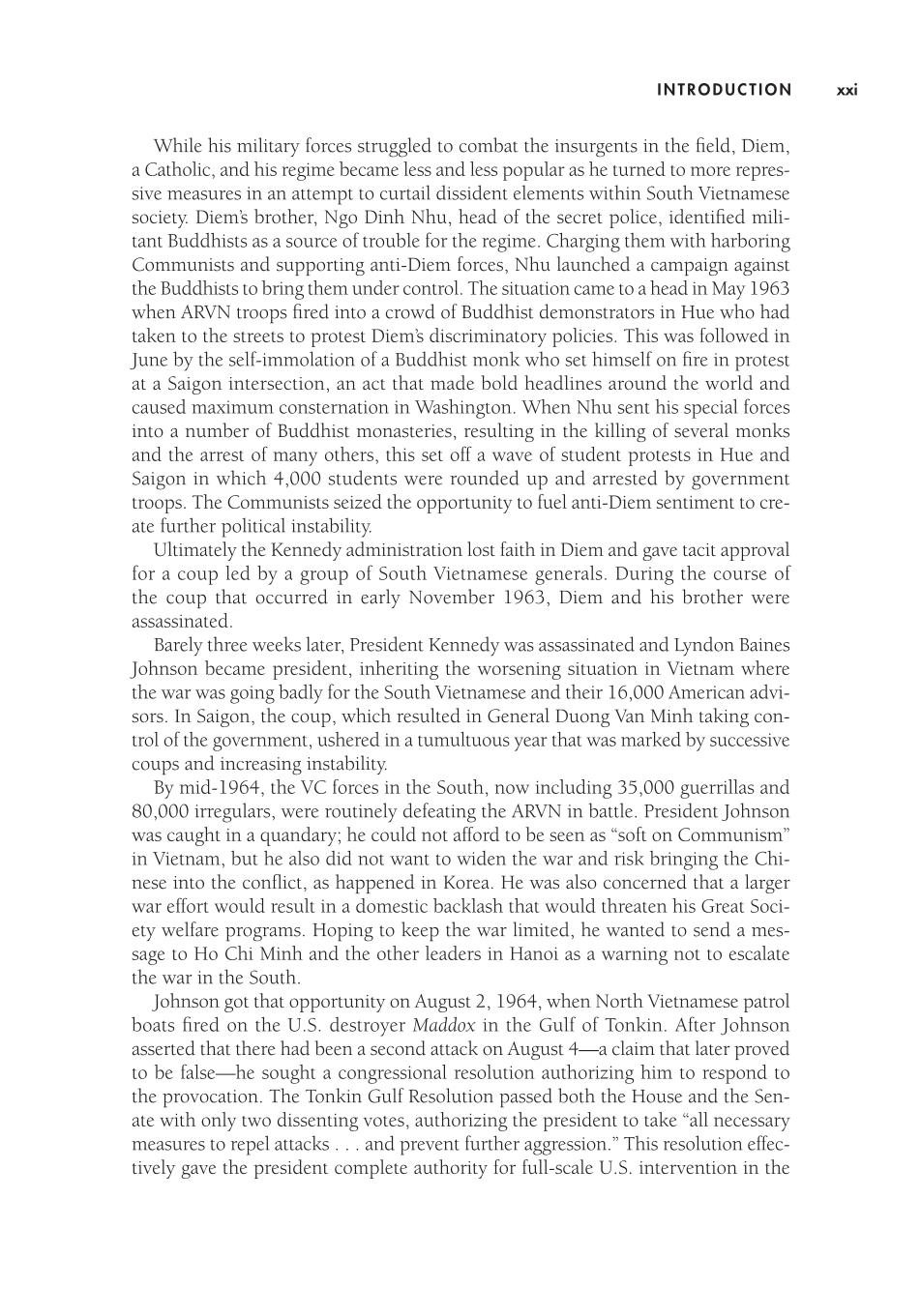I ntroduction xxi
While his military forces struggled to combat the insurgents in the field, Diem,
a Catholic, and his regime became less and less popular as he turned to more repres-
sive measures in an attempt to curtail dissident elements within South Vietnamese
society. Diem’s brother, Ngo Dinh Nhu, head of the secret police, identified mili-
tant Buddhists as a source of trouble for the regime. Charging them with harboring
Communists and supporting anti-Diem forces, Nhu launched a campaign against
the Buddhists to bring them under control. The situation came to a head in May 1963
when ARVN troops fired into a crowd of Buddhist demonstrators in Hue who had
taken to the streets to protest Diem’s discriminatory policies. This was followed in
June by the self-immolation of a Buddhist monk who set himself on fire in protest
at a Saigon intersection, an act that made bold headlines around the world and
caused maximum consternation in Washington. When Nhu sent his special forces
into a number of Buddhist monasteries, resulting in the killing of several monks
and the arrest of many others, this set off a wave of student protests in Hue and
Saigon in which 4,000 students were rounded up and arrested by government
troops. The Communists seized the opportunity to fuel anti-Diem sentiment to cre-
ate further political instability.
Ultimately the Kennedy administration lost faith in Diem and gave tacit approval
for a coup led by a group of South Vietnamese generals. During the course of
the coup that occurred in early November 1963, Diem and his brother were
assassinated.
Barely three weeks later, President Kennedy was assassinated and Lyndon Baines
Johnson became president, inheriting the worsening situation in Vietnam where
the war was going badly for the South Vietnamese and their 16,000 American advi-
sors. In Saigon, the coup, which resulted in General Duong Van Minh taking con-
trol of the government, ushered in a tumultuous year that was marked by successive
coups and increasing instability.
By mid-1964, the VC forces in the South, now including 35,000 guerrillas and
80,000 irregulars, were routinely defeating the ARVN in battle. President Johnson
was caught in a quandary; he could not afford to be seen as “soft on Communism”
in Vietnam, but he also did not want to widen the war and risk bringing the Chi-
nese into the conflict, as happened in Korea. He was also concerned that a larger
war effort would result in a domestic backlash that would threaten his Great Soci-
ety welfare programs. Hoping to keep the war limited, he wanted to send a mes-
sage to Ho Chi Minh and the other leaders in Hanoi as a warning not to escalate
the war in the South.
Johnson got that opportunity on August 2, 1964, when North Vietnamese patrol
boats fired on the U.S. destroyer Maddox in the Gulf of Tonkin. After Johnson
asserted that there had been a second attack on August 4— a claim that later proved
to be false—he sought a congressional resolution authorizing him to respond to
the provocation. The Tonkin Gulf Resolution passed both the House and the Sen-
ate with only two dissenting votes, authorizing the president to take “all necessary
measures to repel attacks . . . and prevent further aggression.” This resolution effec-
tively gave the president complete authority for full-scale U.S. intervention in the





















































































































































































































































































































































































































































































































































































































































































































































































































































































